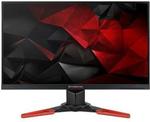Acer Predator XB1 27inch WQHD IPS G-Sync 144Hz Gaming Monitor
Acer Predator XB1 27inch IPS LED Gaming Monitor, 2560x1440, 4ms, 144Hz (165Hz OC), G-Sync, 1000:1 Contrast, DisplayPort, HDMI, USB3 Hub, Tilt, Swivel, Pivot, Height Adjust, VESA COmpatible
Tends to be around the $800 - $900 mark, so around $100 off.



Is it a bargain for this specific product?
Yes, yes it is.
Is it value, compared to the viewsonic 27" with identical stats, at below $400?
No, no it is not.
Also, while this monitor has slightly better pixel response in testing, the viewsonic has near VA level black uniformity on the viewsonic. Its an amazing panel.